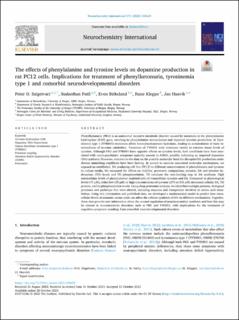| dc.description.abstract | Phenylketonuria (PKU) is an autosomal recessive metabolic disorder caused by mutations in the phenylalanine hydroxylase (PAH) gene, resulting in phenylalanine accumulation and impaired tyrosine production. In Tyrosinemia type 1 (TYRSN1) mutations affect fumarylacetoacetate hydrolase, leading to accumulation of toxic intermediates of tyrosine catabolism. Treatment of TYRSN1 with nitisinone results in extreme tissue levels of tyrosine. Although PKU and TYRSN1 have opposite effects on tyrosine levels, both conditions have been associated with neuro-psychiatric symptoms typically present in ADHD, possibly indicating an impaired dopamine (DA) synthesis. However, concrete in vivo data on the possible molecular basis for disrupted DA production under disease mimicking conditions have been lacking. In pursuit to uncover associated molecular mechanisms, we exposed an established, DA producing cell line (PC12) to different concentrations of phenylalanine and tyrosine in culture media. We measured the effects on viability, proteomic composition, tyrosine, DA and tyrosine hydroxylase (TH) levels and TH phosphorylation. TH catalyzes the rate-limiting step in DA synthesis. High extracellular levels of phenylalanine depleted cells of intracellular tyrosine and DA. Compared to physiological levels (75 μM), either low (35 μM) or high concentrations of tyrosine (275 or 835 μM) decreased cellular DA, TH protein, and its phosphorylation levels. Using deep proteomic analysis, we identified multiple proteins, biological processes and pathways that were altered, including enzymes and transporters involved in amino acid metabolism. Using this information and published data, we developed a mathematical model to predict how extracellular levels of aromatic amino acids can affect the cellular synthesis of DA via different mechanisms. Together, these data provide new information about the normal regulation of neurotransmitter synthesis and how this may be altered in neurometabolic disorders, such as PKU and TYRSN1, with implications for the treatment of cognitive symptoms resulting from comorbid neurodevelopmental disorders. | en_US |

